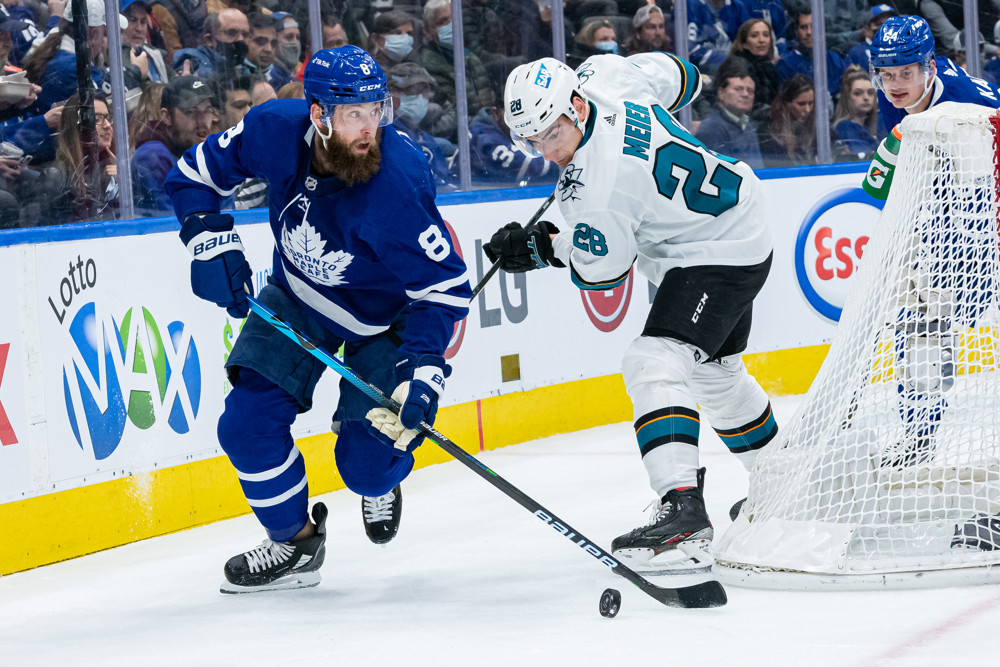Why the Toronto Maple Leafs Might Have a Jake Muzzin Problem
Much has been made of the Toronto Maple Leafs’ early struggles in 2021-22. Their superstar forwards resemble shells of their former selves. The defense is a mess. Prior to the team’s nip-and-tuck win against the lifeless Chicago Blackhawks on Wednesday night, there were even whispers surrounding head coach Sheldon Keefe’s job security.
The club finds itself in total disarray. However, these issues haven’t surfaced out of the blue. The Leafs’ recent postseason fiascos have simply begun to bleed into the regular season.
Maybe the core of Auston Matthews, Mitch Marner, John Tavares, William Nylander and newly re-signed Morgan Rielly doesn’t have the right stuff.
But this damning label wasn’t supposed to fit Jake Muzzin. The veteran blueliner played an integral role in the Los Angeles Kings’ 2014 Stanley Cup run, and since his Leafs arrival in January 2019, he’s provided a hard-nosed and steadying presence to their back end.
Those contributions seem like a distant memory.
Through eight games, Muzzin’s play hasn’t merely deteriorated. The 32-year-old has been one of the worst high-usage blueliners in the entire league. Consider this night-and-day contrast: During his 5-on-5 shifts, Toronto has gone from conceding 2.17 to 4.94 goals per 60 minutes. His GA60 this season ranks 113th out of 115 defensemen (100+ minutes played).
His expected goals-against rate hasn’t soared to quite the same degree (1.92 to 2.50), which might suggest he’s had some lousy puck luck. His on-ice save percentage of 85.7 is certainly far below last year’s mark of 91.8. However, that dramatic fall may well be the result of his own performance. After all, Toronto is giving up significantly more high-danger chances when he’s on the ice this season (8.74 to 12.57 per 60 minutes).
And when he slips up, he makes it count. Look at how spectacularly he flounders on these goals:
Whether it’s due to his age or lingering injuries, he comes off as…incompetent at the moment. That’s the last descriptor you would think to apply to Muzzin, but the film doesn’t lie. He’s routinely caught behind the play, he’s slow to track puck-carriers and his defensive fundamentals have disappeared overnight.
The scary bit is that it could be so much worse. He’s been guilty of egregious mistakes that should have resulted in more goals against. Too often, he’s wandering in no man’s land and not in sync with overmatched partner Justin Holl.
Here’s a quick reel of some uncharacteristic—and unsightly—sequences:
Muzzin’s once-stout defensive play is nowhere to be seen. He’s leaving his post to chase opponents and hanging his teammates out to dry. He’s trying to undercut passes instead of maintaining inside position. Thanks to the black cloud looming over this club, he can’t take a breath to get his bearings either.
Context makes this sudden decline all the more damaging. In their time together, Holl has heavily relied on Muzzin to bail him out. Over the past three campaigns, his xGF% (55.5 to 46.5) and GF% (52.9 to 42.9) tumble without Muzzin. The lanky 29-year-old is a sluggish thinker and skater who frequently allows opponents to sneak behind him. Without his partner breaking up plays and initiating the breakout, he’s completely out of his depth. Even dumping the puck in is a struggle.
Moreover, Keefe trusts the pair to face stiff competition. Toronto’s bench boss can’t really assign those duties to anyone else.
Rielly remains an abject disaster on defense, allowing expected goals at a higher rate than Muzzin this season (and every other year). He’s prone to turnovers and baffling lapses in his end. Two of Travis Dermott, Rasmus Sandin and Timothy Liljegren comprise the third pairing, and while it’s faring reasonably well in sheltered minutes, it’s still raw from a defensive perspective. Throwing them into the fire would not be wise.
The coaching staff is thus stuck between a rock and a hard place.
Worse still, Muzzin’s woes have extended to his play in possession as well. Typically a safe decision-maker who supplements the attack with an efficient and trigger-happy approach, he’s now fighting the puck in all three zones. The basics are causing him trouble:
He’s preventing his team from gaining any momentum with the puck, and he’s fishing it out of his net with alarming frequency. That’s…a bad combo.
What measures can Keefe take to remedy the situation?
The Muzzin-Holl pairing is buckling under similar responsibilities to last season. Rielly is who he is and the inconsistent TJ Brodie ranks 114th out of 115 defensemen in high-danger opportunities against. TSN’s Mark Masters reported on Friday that these longstanding pairings are finally set to change. Dermott is climbing the depth chart to play alongside Rielly, whereas Muzzin and Brodie will form a new partnership. Holl, meanwhile, practiced as the seventh defenseman.
Perhaps these configurations can drive home each pairing’s purpose: Rielly and Dermott are mobile puck-movers who can facilitate for the big guns, and Muzzin and Brodie are a purely defensive duo. A dose of clarity is always welcome.
Regardless of his partner’s identity, it’s evident that Muzzin is the man tasked with shutting down the opposition’s weapons. He must shake off the cobwebs sooner rather than later because the Leafs’ 3-4-1 record doesn’t reflect their appalling defensive play. They rank 27th in HDCA60, 24th in xGA60 and 26th in GA60. They need his poise and stability on a blue line that features very little of those traits. Their confidence is already frittering with each passing game.
If Muzzin can’t rediscover his form, the team may crumble altogether.
Recent Posts

How Corey Perry Is Making His Presence Felt With the Lightning
View Post »
How Adam Fox Pushed the Rangers Past the Penguins
View Post »

